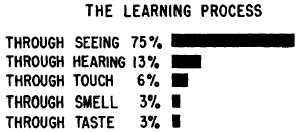one another. Sight and hearing together produce
a more vivid and lasting impression than either
sight or hearing alone could produce. The other
senses are effective to a lesser degree. Figure 7-1
is a graphic comparison of the amount of
learning an individual would normally acquire
through each of the five senses.
TEACHING PROCEDURE
There are several methods that may be
employed by RE instructors in teaching a lesson.
Those most frequently used are the lecture, the
discussion, and the demonstration. Occasion-
ally, only one of these methods is best suited for
an entire lesson. In most cases, however, a com-
bination of the three methods will prove most
effective.
Effective teaching follows a definite, well-
established procedure that has proved effective
for most training programs. This procedure con-
sists of four major steps. First, it is necessary to
prepare students to a degree where they are
ready to learn. This is called the WARMUP
step. Second, the new material is presented to
the students: this constitutes the PRESENTA-
TION step. The third step, APPLICATION,
provides students an opportunity to practice
what they have learned. The fourth and final
step, TESTING, enables the instructor to
evaluate the results of his instruction.
Warmup
The first of four steps in teaching (warmup)
serves a dual purpose. It prepares the minds of
243.57
Figure 7-1.—Graph of the learning process.
students to receive the new information and it
arouses interest in the subject. The skill of an RE
instructor is tested in this step. The instructor
must be able to determine whether or not
students have knowledge on which the new
information may be built. The instructor must
also create an interest and a desire on the part of
the students to learn the new material.
Students can interpret new information only
in terms of past experiences. In a well-organized
program, each lesson forms a foundation on
which to build succeeding lessons. However, in
introducing new subject matter, it may be
necessary to build on experience that students
have acquired prior to the course of instruction.
In introducing the new lesson and correlating
it with previous lessons, the RE instructor must
try to arouse the students’ interest. It is useless
to attempt to teach until the teacher has cap-
tured the interest and attention of the students.
Remember that the purpose of the warmup is to
motivate the trainees to learn. The RE instructor
may use a variety of techniques to create interest
and capture the students’ attention.
Presentation
In the warmup, students are being prepared
to receive new ideas and information and to
have their interest aroused in the subject. They
receive very little, if any, new information. The
presentation step, as the name implies, consists
of presenting the lesson in a clear, concise, and
logical manner so that maximum learning takes
place.
Various methods and devices have been
developed for carrying out this instructional
procedure.
In choosing teaching tools, the RE instructor
must decide whether to use the TELLING,
SHOWING, or DOING method, or a combina-
tion of these methods. In general, the method of
instruction to be followed in the presentation
step is determined by the subject, the aim of the
lesson,
the equipment available, and the
qualifications of the students.
Following the presentation of each major
point in the assignment, the RE instructor
should check to make sure that the students
7-2

